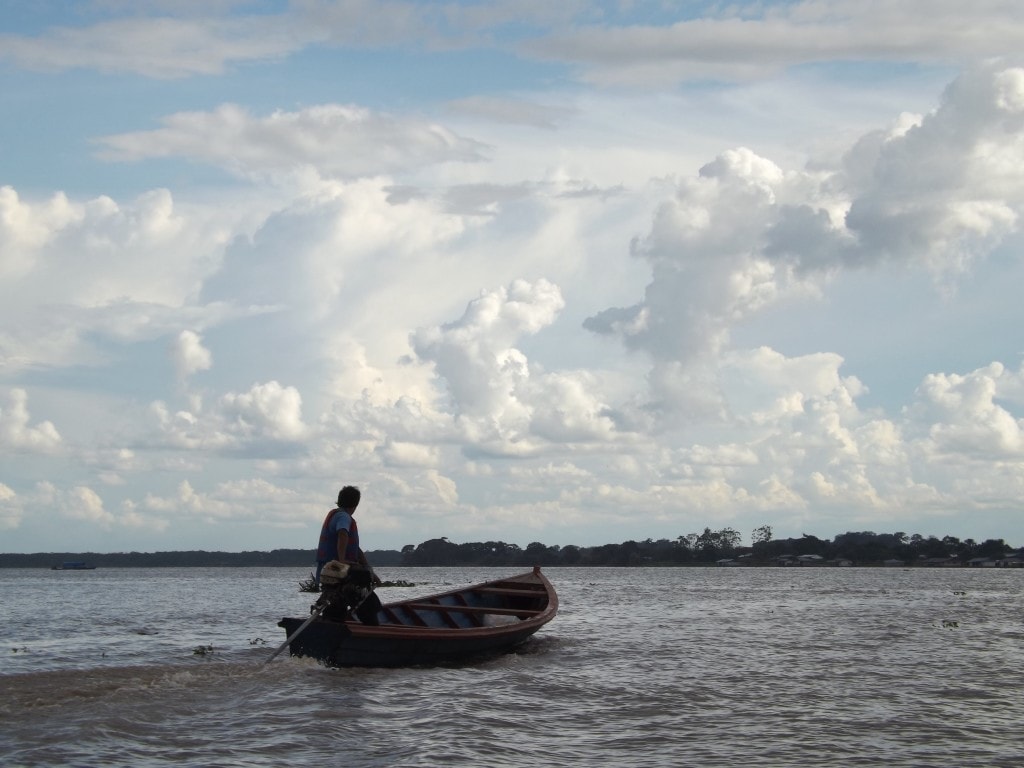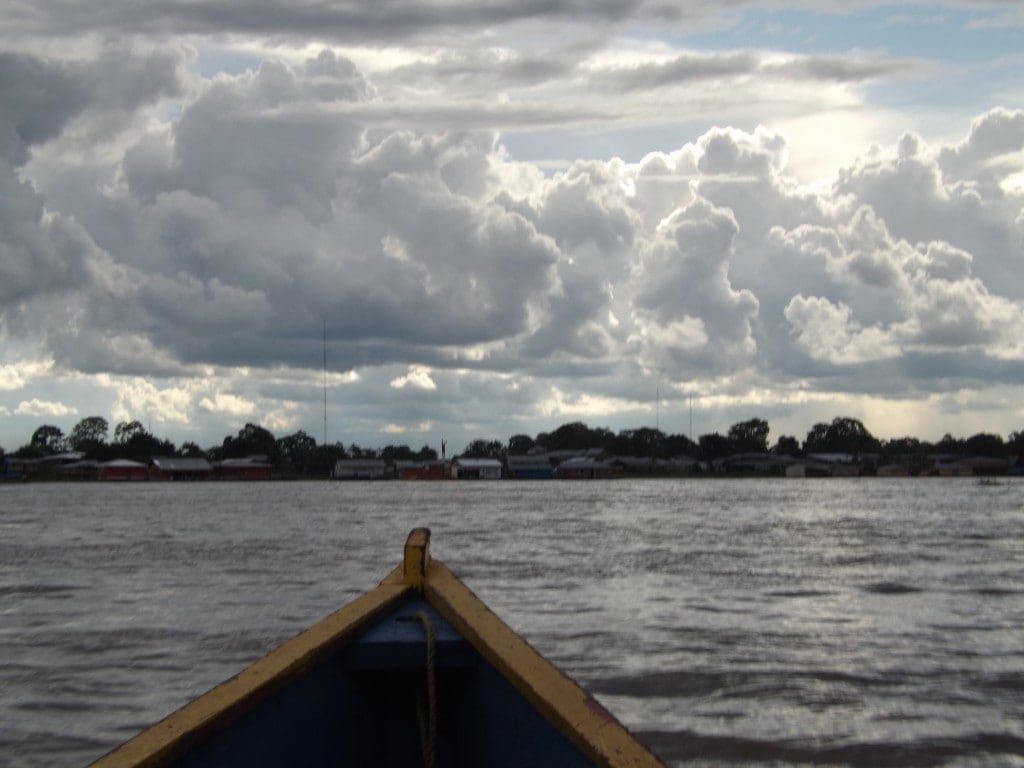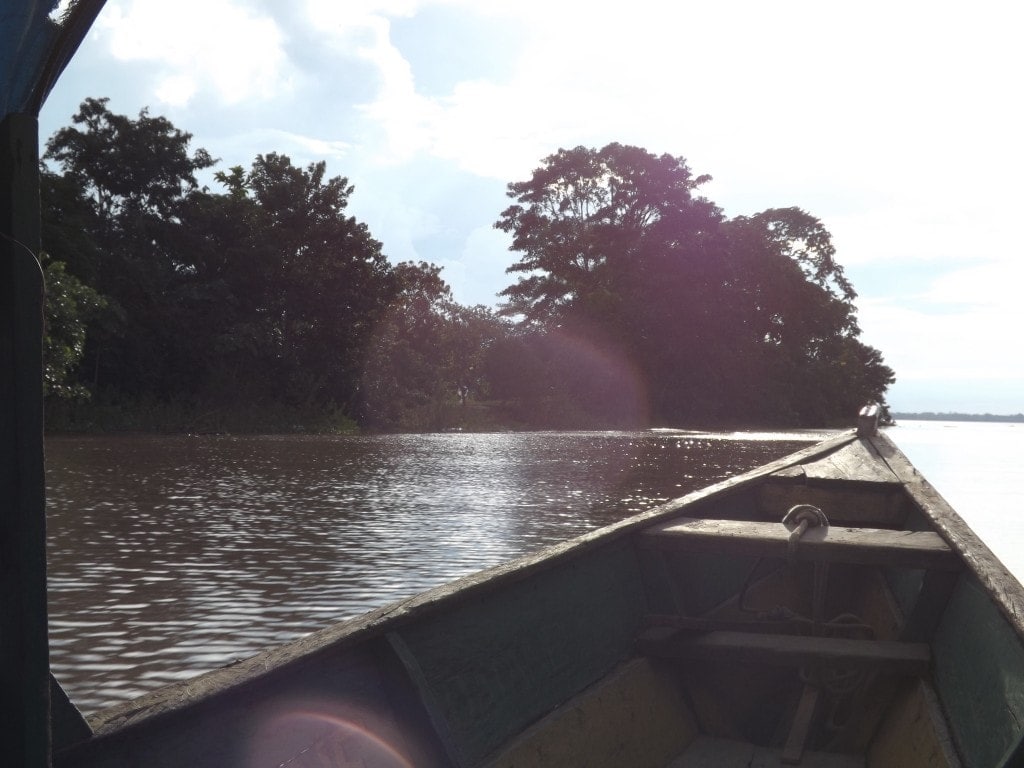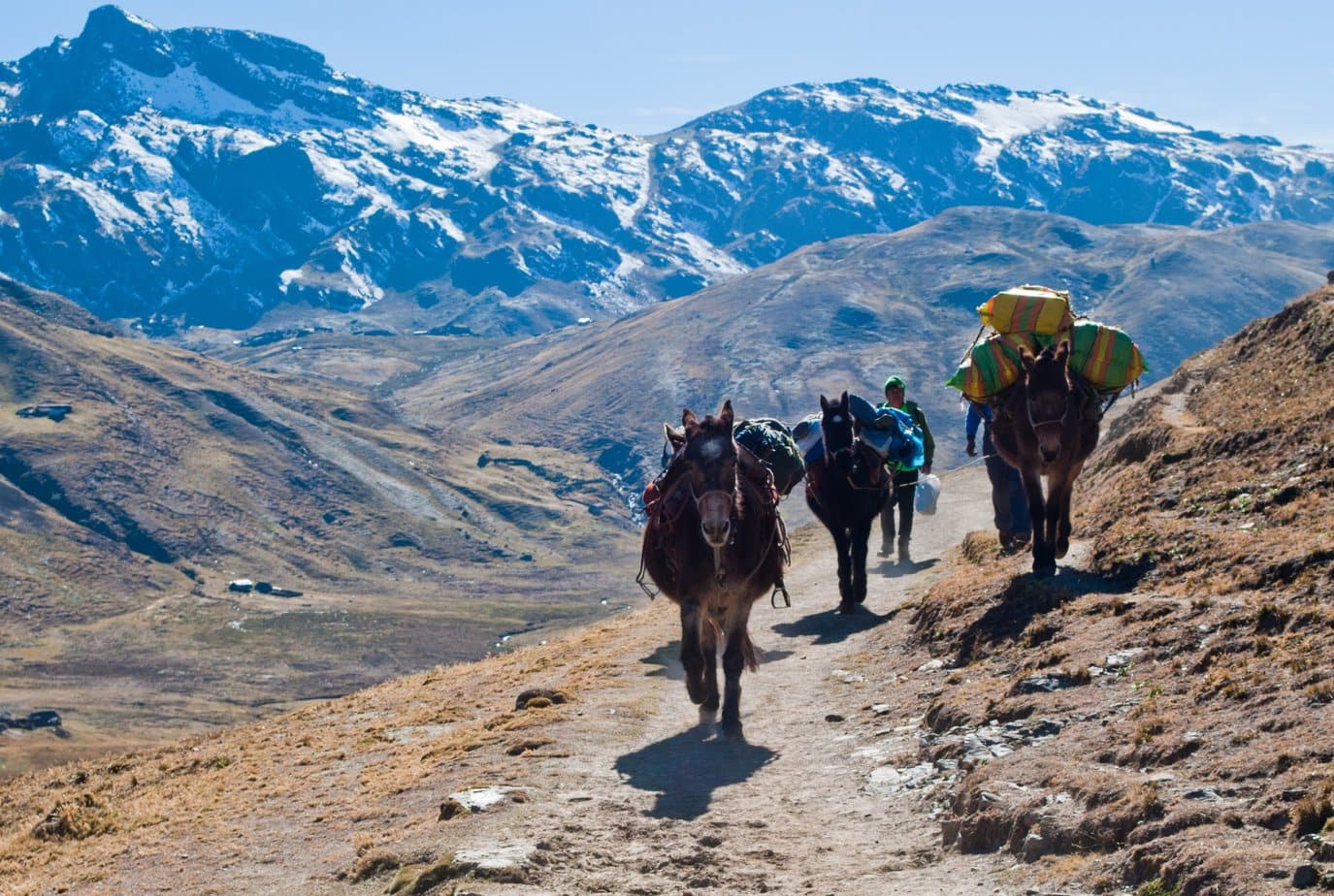Some posts on this site contain affiliate links. If you book or buy something through these links, I earn a small commission (at no extra cost to you). Take a look at my privacy policy for more information.

If you want to travel from Colombia to Peru by boat, it can be hard to figure out just how to do this. So I’ve compiled a post all about it, based on my experiences, to help you travel from Leticia down the Amazon into Peru.
Although I wrote this post a few years ago, the experience remains fairly similar. Prices and timings are likely to change so be sure to check details when you’re actually in Colombia.
However, I will endeavour to keep this post as up-to-date as possible and will make changes whenever I learn anything new.
If you’ve travelled the overland route from Colombia to Peru recently, feel free to leave a comment at the bottom of the page to relay your experience – and let me know if there’s any new info I should include. Help me keep this post-up-to-date to help out fellow travellers!
How to Get to Leticia
The town of Leticia, in Colombia’s bottom right corner, is right on the borders with Brazil and Peru, and it’s possible to reach both countries via boat. You can fly to Leticia from anywhere in Colombia via a connection in Bogota. Both Avianca and LATAM have daily flights to Leticia.
At the airport in Leticia, you need to get your passport stamped with an exit stamp for Colombia. You can’t do this on the boat and they won’t let you sail, or get your Peru entry stamp, without it. The immigration office is within the main airport building, after you disembark from the plane and go through baggage collection etc.
Colombia to Peru by Boat – the Options
1) The Slow Boat
The slow boat takes two – three days. I’ve spoken to people who have taken this option, they have said the boats are comfy enough but overcrowded; many shared space with cargo and animals like pigs and sheep. Lodgings are usually hammocks in a public space, food is provided, but the boats are unreliable – I’ve hear reports of them sailing four days after originally planned. According to Alexa at Amazon B&B, the slow boats cost about $30-35.
You can book tickets through travel agencies in Santa Rosa, or directly on the boat. The price varies depending on the standard of class – but do not forget these are cargo boats! They offer a very basic standard of accommodation etc.
2) The Rapido / Speed Boat
The rapido takes between eight – ten hours depending on current and weather conditions etc. These leave every day except Monday at around 3/4 am. This was the option I chose, so the rest of this post will deal with the rapidos…
Once in Leticia, you need to hop the border into Brazil to buy your tickets for the boat. You can do this in a taxi or tuc-tuc: the Brazilian town of Tabatinga is right next to Leticia and there is no border control here, so no passport needed. In Tabatinga, there are two companies selling tickets; Transtur and Golphino. Both companies leave on alternate days, so which one you book depends on which day you want to leave:
Transtur currently sail on Wednesday, Friday, and Sunday. The other company sail on Tuesday and Thursday.
As of March 2014, a ticket for the rapido with Transtur (including two meals) cost 200,000 COP (about £50) per person.
Getting Your Immigration Stamps
The boat leaves from Santa Rosa, which is across the river from Leticia and is in Peru. Again, there’s no border crossing or passports needed.
Once you have your tickets, and your Colombian exit stamp from the airport, you need to head to Santa Rosa in a ferry (5000 COP – £1 – pp) to get your Peruvian entry stamp. The immigration office is right by the small port at Santa Rosa, any local will be able to point it out to you.

The immigration office will give you a stamp in your passport, and will ask how long you plan to be in Peru. Always say more than you really plan, in case you run over. If you say one month they will write ’30 days’ on your passport stamp, and if you stay in the country any longer than that you will be charged $1 per extra day when you leave. If you plan to be there for 30 days, say 45 and cover your back.
The immigration office will also give you a small white immigration card. They won’t staple it in your passport and they will not tell you how important it is – but it is so important! DO NOT throw away this immigration card – without it you will be charged additional taxes in most hotels/hostels and will have complications when trying to leave the country, especially at a land border (you may not be able to leave without heading back to the nearest airport to get a new card). FYI – if you lose your card, you can pick up a new one for S./30 (£6 GBP) at an immigration office in most major cities like Lima and Cusco.
Where to Stay in Leticia
Once you have your exit stamp, boat tickets, and entry stamp, you’re free to relax. The boats leave at about 3:30am most days – the actual time will be confirmed on your ticket. My advice is to stay in Santa Rosa – Leticia is the bigger, more modern town (with nicer hotels) but it will make getting to the port in the morning much more difficult and you’ll need to leave earlier. In Santa Rosa there are very cheap hotels right next to where the boat leaves, so you can stay in bed that much longer.
According to my local contact, there is a risk of dengue in Santa Rosa during summer time, and that the sanitary conditions are fairly poor. There is also no electricity in Santa Rosa at night.
Amazon B&B are the ones who helped me update this post with current prices and information. They’re a local business and might be a nice place to stay before your trip. They also can help you booking your boat ticket, and with sorting out the migration etc. The staff can provide a breakfast box for your journey, which is a nice idea as the food on board isn’t great.
There are a few jungle tours that you can do around Leticia and Santa Rosa while you’re waiting for your boat – but go with a reputable company to avoid getting ripped off like we did. A good idea might be to see if you hire a ferry driver and ask him to take you down the river at sunset, it’ll be much cheaper than a tour and you have a good chance of spotting river dolphins around that time. The views from the river are incredible!

Taking the boat from Colombia to Peru – What to Expect
Get an early night – you will thank yourself at 3am the next morning when you are struggling to sleep on a crowded boat.
The fast boats are narrow motor boats with about 30 seats. These don’t recline and are pretty packed in, so don’t hold out hope for much leg room.
There is a toilet on board but no soap, and the paper ran out about halfway – so take some tissues and an anti-bac hand gel in your carry-on. I also recommend taking a few wet wipes so that you can clean your hands an face.
Two meals are provided by Transtur: breakfast about 7am (coffee and a roll/sandwich), and a hot lunch at around midday (meat with rice, fizzy drinks). It’s a good idea to take fruit or salad with you so that you can eat healthily. You should also take plenty of water for the journey – check out my review of the Water-to-Go Filter Bottle and grab a 15% discount using my code ELUX15.
The boat is scheduled to take ten hours, but can take less or more time depending on conditions. Take a lot of reading material and music, and prepare yourself for a long ride!
The river journey down the Amazon into Peru sounds romantic – but it is also uncomfortable and tough. If you don’t like discomfort, dirty hotel rooms, stress, uncertainty, cramped spaces, or travelling by water, then I would recommend taking the plane. The journey is rewarding but you need to be prepared for it!
Useful Contacts
Contacts: the official Peru tourist board website contains up-to-date info and is a good place to check for clarification. You can also contact the tourist board advice centre by both WhatsApp and email, click here for the contact details.
Read all about my experiences on the Amazon river here.




Great tips, I’ve been to Peru but never had the chance to see its side of the Amazon!
Thank you! It was an amazing experience – very stressful but totally worth it! I tried to write a post with everything I wish I’d known before setting out!
Thanks for this usefull post – I didn’t know you could get from Colombia to Peru via the Amazon river – I was planning on flying but this sounds much better! Thanks for the inspiration and ideas for my own trip! Keep enoying South America and keep up the great posts :)
Hi Anna! I’m so glad this came in handy for you – it was so tricky trying to figure out how to do anything so I wanted to post as many helpful hints as I could think of! However you get into Peru, be careful about those immigration tips – we had to learn the hard way and it cost us a lot of extra time and money! Enjoy your trip :D
Hi Emily.. me and my gf are looking into the same route u took from Leticia to Iquitos. And i found alot of good help in your blog. Im curious how u got from Iquitos further into Peru? We are traveling thru South America, we are gonna be on the road for 3,5 months-isch. So we are trying to keep it as cheap as possible. Do u have any good advice or ideas on what to look into? The boat to the next town takes to long, so we are gonna have to fly.
Grateful for any advice and ideas..
/ Eddie
From Iquitos I flew to Tarapoto, which is the nearest city so flights were fairly cheap. From there we took a bus to the coast, Chiclayo I think, and then worked our way down the coast. You can’t get out of Iquitos except by boat or air as there are no roads, so yeah, it’s either take a boat to Tarapoto which I think takes several days, or fly onwards. Depending on where you want to swap, it may work out cheaper and easier to fly straight to Lima which I think you can also do from Iquitos.
Good luck with the trip – the Amazon is a really cool experience :)
Hi again.. another question. Is it difficult to find accomodation on santa rosa? We cant find anything online
When I visited it wasn’t at all difficult. Literally opposite the place where the ferry leaves there is a hotel. Very basic but it’s cheap and does the job for one night. There are quite a few basic hotels and dorms around, no wifi so I’m not surprised they aren’t online. You should have no trouble finding a place to sleep :)
Good luck with the journey!
Dear Emily, thank you for your helpful and complete explanations. I leave in Leticia and work at Hotel Amazon Bed and Breakfast, and this is the best information that I found to refer our guests. Even the article is from 2014 your article is still reliable. Thank you :)
Thanks so much Alex! Glad to hear the info is still pretty relevant :)
Hi Emily,
great article, thanks for useful information! There is one thing which is unclear for me. In the article is written that it’s last updated 28.7.2021 but I didn’t find any information about COVID. So how is it nowdays? Is it still possible to take a boat from Colombia to Peru?
Many thanks,
Tomas, Slovakia
Hi Tomas! I decided not to put any Covid info within the post as it all changes so fast and I worried about info becoming outdated. Having a look now and it appears you can travel to Peru as long as you have a vaccine and fill out a passenger affidavit (you might need to sort and print that before getting to Leticia). There’s quite a bit of info on the UK gov page for Per trvel: https://www.gov.uk/foreign-travel-advice/peru/entry-requirements
I can’t find out for sure if the boats are still running at the moment but I think they are as a lot of locals use them. You could try emailing or phoning some of the local hotels to ask if they know if the boat is running. Sorry I can’t be more help! Good luck with the trip :)
Hi Emily,
Myself and a couple of friends are thinking of travelling by boat, but from Peru to Colombia – the opposite way from how you did it. Do you know whether boats travel this alternate route? The only info I have found about travelling from the two countries by boat is your super helpful blog post!
Mia
Hi Mia. I haven’t travelled that direction myself but I know that you can do it. The same boats that travel from Colombia to Peru also go back. You would need to go to Iquitos and take the boat from there. You’ll need to get your passport stamped for the exit (and for entry at the other end) but there should be an immigration office in Iquitos. I’d recommend arriving a day or two early so that you can get advice and get things sorted. There is an IPeru Tourist Office (the official tourist information office) in Iquitos so you could try emailing/calling them for further clarification, you can find their contact details here: https://www.peru.travel/en/useful-data/iperu
What if you just wanted to land in Leticia and take a ferry to Santa Rosa Peru, literally turn around and take the same ferry back to Leticia so that you can say that you’ve been to the 3 countries?
.
Is this doable?
Can you book the ferry to just take you across the river and back, or is the only way to get on the ferry is to buy a ticket for the long boat ride to Iquitos?
Hi Edwin! You absolutely could do that – there’s a separate ferry across the river from Leticia and Santa Rosa. It’s only a dollar or two to make the crossing and as far as I remember itruns very often. However, there’s not much of interest to see in Leticia, so I’m not sure it would be worth the cost and time of flying all the way there just to say you’ve been to those 3 countries. You could always do one of the river cruises and hopefully spot some of the freshwater dolphins and other wildlife.
Hi Emily!
First thanks for the info! One question in case we want to do a tour in the Amazon and then cross the border to Perù with the boat, Is it already possibile to get
the stamp in Leticia Airport? Or you cannot do it days before crossing?
How much are less or more the tour in case you know It? Thanks a lot
Hi Luca! I think officially you are supposed to get the exit stamp on the same day that you leave. However we got ours the day before taking the boat to Peru – and we got the Peru entry stamp the day before as well. So I think they are a little relaxed with the rules – the important thing is just that you get both stamps, or you could run into problems. For example if you revisit Colombia as it will look like you never left!
Tours have probably gone up in price since I was last there, but they weren’t too expensive. You can pre-book some on Viator so that’s a good way to get an idea of prices: https://www.viator.com/en-GB/Leticia/d51209-ttd?pid=P00084748&mcid=42383&medium=link (Affiliate link). It would most likely be cheaper if you book when you get there, as you can shop around and haggle. But sometimes booking online is much easier :)
Hope that helps!